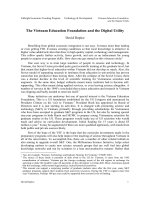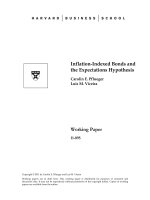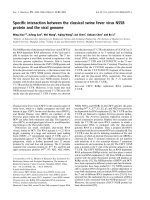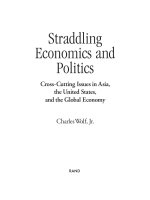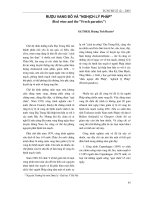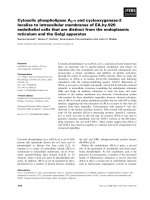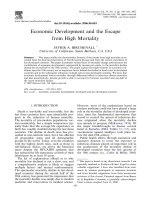Entrepreneurship, Economic Conditions, and the Great Recession pdf
Bạn đang xem bản rút gọn của tài liệu. Xem và tải ngay bản đầy đủ của tài liệu tại đây (2.93 MB, 47 trang )
Entrepreneurship, Economic Conditions, and the Great Recession
Robert W. Fairlie
Department of Economics
University of California
Santa Cruz, CA 95064
IZA and RAND
May 2011
Abstract
The “Great Recession” resulted in many business closings and foreclosures, but what effect did it
have on business formation? On the one hand, recessions decrease potential business income and
wealth, but on the other hand they restrict opportunities in the wage/salary sector leaving the net
effect on entrepreneurship ambiguous. The most up-to-date microdata available the 1996 to
2009 Current Population Survey (CPS) are used to conduct a detailed analysis of the
determinants of entrepreneurship at the individual level to shed light on this question. Regression
estimates indicate that local labor market conditions are a major determinant of entrepreneurship.
Higher local unemployment rates are found to increase the probability that individuals start
businesses. Home ownership and local home values for home owners are also found to have
positive effects on business creation, but these effects are noticeably smaller. Additional
regression estimates indicate that individuals who are initially not employed respond more to high
local unemployment rates by starting businesses than wage/salary workers. The results point to a
consistent picture – the positive influences of slack labor markets outweigh the negative
influences resulting in higher levels of business creation. Using the regression estimates for the
local unemployment rate effects, I find that the predicted trend in entrepreneurship rates tracks
the actual upward trend in entrepreneurship extremely well in the Great Recession.
Keywords: Entrepreneurship, Great Recession, Unemployment, Self-Employment
JEL Code: L26
This research was supported by the Kauffman-RAND Institute for Entrepreneurship Public Policy
through a grant from the Ewing Marion Kauffman Foundation. I would like to thank Susan Gates,
John Robertson, Danny Leung, and seminar participants at the Small Business, Entrepreneurship,
and Economic Recovery Conference at the Atlanta Federal Reserve and the CIRPEE-IVEY
Conference on Macroeconomics and Entrepreneurship for helpful comments and suggestions.
1. Introduction
The U.S. Economy lost more than 8 million jobs during the recession starting in
December 2007. The national unemployment rate rose to over 10 percent, which is twice as high
as it was at the start of the recession. Many researchers have noted that the labor market
experienced its deepest downturn in the postwar era in the recent recession (Elsby, Hobijn and
Sahin 2010). Sparking the recession was the housing crisis housing prices plummeted since
reaching their peak in mid 2007. The national housing price index experienced the largest decline
on record (Federal Housing Finance Agency 2009). Home foreclosures also rose rapidly over the
past few years. In the one period for May 2010, there were 323,000 foreclosure filings,
representing an alarming 1 out every 400 housing units in the United States (Realtytrac 2010).
What effect did the recent recession, and recessions more generally, have on
entrepreneurship? Were would-be-entrepreneurs dissuaded by the recent recession from starting
businesses or did they respond to layoffs and slack labor markets by turning to self-employed
business ownership? Business bankruptcy filings and closures increased sharply in the recent
recession (U.S. Courts 2010), but the effects on business formation are less clear. Recessions
might have a negative effect on business starts because of the resulting decline in demand for the
products and services produced by businesses. The recent housing slump may have limited
entrepreneurship by restricting access to capital. Equity in one's home is the main asset for most
Americans and represents 60 percent of all wealth (U.S. Census 2008). Home equity and other
forms of personal wealth are important for starting businesses because they can be invested
directly in the business or used as collateral to obtain business loans. Bank loans, venture capital
and angel investments were also difficult to obtain during the recent recession (Federal Reserve
Board of Governors 2010, PricewaterhouseCoopers 2010).
On the other hand, the recent recession might have increased "necessity"
entrepreneurship or business creation because of the rapid rise in the number of layoffs and
unemployment in the United States. Previous studies provide evidence that job loss and reduced
2
labor market opportunities lead to entry into self-employed business ownership (Farber 1999;
Parker 2009; Krashinsky 2005). Although the motivation might differ for starting the business in
this case, many of these businesses may eventually be very successful. For example, a recent
study by Stangler (2009) finds that the majority of Fortune 500 companies were started during
recessions or bear markets.
Given these opposing forces, the net effect of the recent recession on business creations is
ambiguous. Indeed, the positive and negative influences may have even cancelled out resulting in
a relatively flat rate of business creation over the business cycle. To explore this question, I first
conduct a detailed analysis of the determinants of entrepreneurship using newly created panel
data from the most up-to-date microdata available the 1996 to 2009 Current Population Survey
(CPS). Although the CPS data are usually used as cross-sectional data, panel data can be created
from the underlying data files allowing one to measure business creation by individuals. Using
these data, the effects of rising unemployment rates and the decline in housing values on
entrepreneurship are examined by estimating the relationship between business creation at the
individual level and local labor and housing markets. The analysis covers two recessions and two
strong growth periods, and uses variation in unemployment and housing prices from more than
250 metropolitan areas. Estimates from this analysis are then used to examine whether rapidly
increasing unemployment rates and a declining housing market had a large effect on business
creation in the Great Recession.
This study is the first to provide a detailed analysis of the effects of the Great Recession
on business creation in the United States. It also improves on previous research on business
formation by capturing a broader range of new business activity than commonly-used Census
data focusing only on new employer firms. Detailed information on home ownership, initial
employment status, education and demographic characteristics of entrepreneurs and non-
entrepreneurs available in the CPS allow for a much more extensive analysis of the relationship
between local economic conditions, housing market conditions, and business formation than
3
previously conducted in the literature. The study provides new evidence on the potentially
opposing influences of unemployment and housing markets on entrepreneurship, interactions
between initial employment status and local labor market conditions, and the types of business
created in weak labor market conditions. The findings from this analysis may have important
policy implications because of the focus of many government programs on promoting business
ownership among the unemployed and the potential for job creation (U.S. Department of Labor
2010, Small Business Administration 2010, OECD 1992, 2005).
2. The Entrepreneurial Decision
Theoretical models of the choice to become self-employed are generally based on a
comparison of potential earnings from business ownership and wage and salary work. In the
classic economic model by Evans and Jovanovic (1989) individuals can obtain the following
income, Y
W
, from the wage and salary sector: Y
W
= w + rA, where w is the wage earned in the
market, r is the interest rate, and A represents the consumer’s assets. Earnings in the self-
employment sector, Y
SE
, are defined as: Y
SE
= θf(k)ε + r(A-k), where θ is entrepreneurial ability,
f(.) is a production function whose only input is capital, ε is a random component to the
production process, and k is the amount of capital purchased by the worker. Individuals choose to
become self-employed if the potential income from self-employment and investing remaining
personal wealth after using it for startup capital is higher than the potential income from wage and
salary work and investing personal wealth.
This simple theoretical model is useful for illustrating the main avenues through which
business cycles might affect entrepreneurship. One of the main effects is that recessions reduce
consumer and firm demand for products and services provided by startups, thus decreasing
potential entrepreneurial earnings, Y
SE
. Recessions may also reduce total wealth, A, which in
turn would lower the likelihood of entrepreneurship. In the presence of liquidity constraints,
lower levels of wealth may make it more difficult for entrepreneurs to find the required startup
4
capital to launch new ventures. Personal wealth may have declined substantially through
declining home values and home ownership rates. Recessions also make it more difficult to
acquire financing from banks, other financial institutions, angel investors, and venture capitalists.
On the other hand, the costs of production are lower in a recession, especially rent and
labor, increasing Y
SE
. The opportunity cost of capital, r, is likely to be lower in recessions also
placing upward pressure on entrepreneurship. Perhaps the largest factor having a positive effect
on the entrepreneurial decision is that compensation in the wage/salary sector decreases in
economic contractions. The positive effect of lower wages on entrepreneurship may be tempered
somewhat in recessions, however, because some workers may be reluctant to leave their jobs in a
recession because of concerns about finding another one if the business fails. The net effect of
these opposing forces on entrepreneurship is ambiguous. An empirical analysis is thus needed.
PREVIOUS EMPIRICAL EVIDENCE
The previous empirical literature provides evidence on several aspects of how recessions
affect the entrepreneurial decision. The relationship between personal wealth and business starts
has been studied extensively in the previous literature using various methodologies, measures of
wealth, and datasets from around the world. Most studies find that asset levels (e.g. net worth)
measured in one year increase the probability of entering self-employment by the following year.
1
The finding has generally been interpreted as providing evidence that entrepreneurs face liquidity
constraints and that owner's wealth is important in determining access to financial capital for
business starts. Additional evidence on the link between startup capital and owner's wealth has
been provided by examining the relationship between business loans and personal commitments,
such as using personal assets for collateral for business liabilities and guarantees that make
1
See Evans and Jovanovic (1989), Evans and Leighton (1989), Meyer (1990), Holtz-Eakin, Joulfaian, and
Rosen (1994), Lindh and Ohlsson (1996, 1998), Bates (1997), Blanchflower and Oswald (1998), Dunn and
Holtz-Eakin (2000), Fairlie (1999), Johansson (2000), Taylor (2001), Zissimopoulos and Karoly (2003),
Holtz-Eakin and Rosen (2005), Giannetti and Simonov (2004), Fairlie and Krashinsky (2010), and Nykvist
(2005).
5
owners personally liable for business debts (Avery, Bostic and Samolyk 1998, Cavalluzzo and
Wolken 2005). Additional evidence on the importance of wealth is provided by the finding that
the substantial racial disparities in wealth found in the United States contribute greatly to why
blacks and Latinos have low business creation rates and worse business outcomes and why Asian
businesses are relatively successful (Bates 1997, Fairlie 1999, Fairlie and Woodruff 2010, Fairlie
and Robb 2007, 2008, Lofstrom and Wang 2009, Bates and Lofstrom 2008).
A smaller literature has examined the relationship between home ownership and
entrepreneurship. The lack of research is surprising because the single largest asset held by most
households is their home. Estimates of home ownership indicate that 67.2 percent of Americans
own their own home with a median home equity of $59,000 (U.S. Census Bureau 2008). The
majority of Americans thus have equity in their homes that may be tapped into for capital to start
businesses or expand a small business. Home ownership and equity are found to be associated
with entrepreneurship and obtaining business loans using Finish data (Johansson 2000), U.K. data
(Black, de Meza, and Jeffreys 1996), and data from the U.S. Survey of Small Business Finances
(Cavalluzzo and Wolken 2005). A comprehensive study of home ownership and business
formation at the individual level, however, has not been conducted in the previous literature. One
area in particular that remains understudied is whether home ownership is important for
entrepreneurship even after controlling for detailed information on education and other
demographic information. Carefully controlling for the effects of education on entrepreneurship
may be especially important because education and wealth are highly correlated and education
has a large positive effect on entrepreneurship and business performance.
2
Previous research on the relationship between unemployment and entrepreneurship
provides mixed results. Parker (2009) reviews the literature and cites many previous studies
showing positive relationships, negative relationships, and zero relationships. He notes, however,
2
See van der Sluis, van Praag and Vijverberg (2005), van Praag (2005), and Moutray (2007) for reviews of
the evidence on the relationship between education and entrepreneurship.
6
that more recent studies are generally finding evidence of a positive or zero relationship between
unemployment and entrepreneurship. A recent paper by Stangler and Kedrosky (2010) using
several data sources finds of a roughly constant rate of firm formation over time. Their analysis of
published aggregate data on employer firm births from the U.S. Census Bureau over the period
from 1977 to 2005 does not indicate a strong cyclical pattern in business formation rates. These
data, however, do not include the time period covered by the Great Recession.
This study builds on the findings of the previous literature by examining the relationship
between entrepreneurship and both conditions in local labor markets and local housing markets. It
is the first study to use data from the Great Recession to estimate this relationship and directly
examine the effects of the Great Recession on business creation. It also provides new evidence
on whether initial employment conditions interact with local labor market conditions in
determining business creation, and the types of businesses created in slack labor market
conditions.
3. Data
Although research on entrepreneurship is growing rapidly, there are very few national
datasets that provide information on the determinants of entrepreneurship. Using matched data
from the 1996-2009 Current Population Surveys (CPS), I use a recently created measure of
entrepreneurship, which captures the rate of business creation at the individual owner level.
National and state-level estimates are reported in Fairlie (2010). The underlying datasets that are
used to create the entrepreneurship measure are the basic monthly files to the Current Population
Survey (CPS). Longitudinal data is created by linking the CPS files over time. These surveys,
conducted monthly by the U.S. Bureau of the Census and the U.S. Bureau of Labor Statistics, are
representative of the entire U.S. population and contain observations for more than 130,000
people. Combining the 1996 to 2009 monthly data creates a sample size of more than 10 million
adult observations. CPS sample weights are used in all analyses.
7
Households in the CPS are interviewed each month over a 4-month period. Eight months
later they are re-interviewed in each month of a second 4-month period. Thus, individuals who
are interviewed in January, February, March and April of one year are interviewed again in
January, February, March and April of the following year. The rotation pattern of the CPS, thus
allows for matching information on individuals monthly for 75 percent of all respondents to each
survey because the four month in the rotation cannot be matched to a subsequent month. To
match these data, I use the household and individual identifiers provided by the CPS. False
matches are removed by comparing race, sex and age codes from the two months. All non-
unique matches are also removed from the dataset. Finally, the datasets provided by the BLS are
checked extensively for coding errors and other problems. Monthly match rates are generally
between 94 and 96 percent, and false positive rates are very low.
3
MEASURING ENTREPRENEURSHIP
Measures of the number and rate of business ownership are available from several large,
nationally representative government datasets, such as the Survey of Business Owners (SBO),
Census PUMS files, and the American Community Survey (ACS). Measures of business
ownership based on these cross-sectional data, however, cannot capture the dynamic nature of
entrepreneurship. A measure of business formation, or the rate of flow into business ownership, is
needed to represent entrepreneurship.
4
Using the matched CPS data over time, I create a measure
of business formation that captures all new business owners including those who own
incorporated or unincorporated businesses, and those who are employers or non-employers.
3
The main reason for non-matching is when someone moves. Therefore, a somewhat non-random sample
(mainly geographic movers) will be lost due to the matching routine. For these month-to-month matches
this does not appear to create a serious problem, however, because the observable characteristics of the
original sample and the matched sample are very similar. See Fairlie (2010) for more details on matching.
4
The Total Entrepreneurial Activity (TEA) index used in the Global Entrepreneurship Monitor captures
individuals who are involved in either the startup phase or managing a business that is less than 42 months
old (Reynolds, Bygrave and Autio 2003).
8
Two of the only other large, nationally representative datasets that provide a measure of
business formation are the Statistics for U.S. Businesses (SUSB) and Business Employment
Dynamics (BED).
5
The CPS data, however, provide for a much broader range of new business
activity than these datasets because the SUSB and BED are limited to measuring only births for
employer establishments or firms. The exclusion of non-employer firms is likely to lead to a
substantial undercount of the rate of entrepreneurship because non-employer firms represent 75
percent of all firms (U.S. Small Business Administration 2001, Headd 2005) and a significant
number of new employer firms start as non-employer firms (Davis, et. al. 2006).
To estimate the business formation rate in the matched CPS data, I first identify all
individuals who do not own a business as their main job in the initial survey month in the two-
month pair. By matching CPS files, I then identify whether they own a business as their main job
with 15 or more usual hours worked in the subsequent survey month.
6
The entrepreneurship rate
is thus defined as the percentage of the population of non-business owners that start a business
each month. To identify whether they are business owners in each month I use information on
their main job defined as the one with the most hours worked. Thus, individuals who start side
businesses will not be counted if they are working more hours on a wage and salary job. The 15
or more hours per week (or roughly 2 or more days per week) criterion is chosen to guarantee a
reasonable work commitment to the new business.
In addition to being able to carefully define entrepreneurship, the CPS data include
information on home ownership and detailed demographic information including race, gender,
age, education and family income at the individual level. Large-scale, nationally representative
5
The SUSB is conducted by the U.S. Census Bureau and reported by the U.S. Small Business
Administration, Office of Advocacy, and the Business Employment Dynamics (BED) is conducted by the
U.S. Bureau of Labor Statistics.
6
All observations with allocated labor force status, class of worker, and hours worked variables are
excluded from the sample. Missing values for variables in the CPS are allocated or imputed by using
several procedures including hot deck procedures and information from previous survey months. These
allocation procedures lead to higher estimated entrepreneurship rates because allocations are likely to
increase the likelihood of changes (see Fairlie 2010 for more details).
9
business-level data include only very limited or no information on the business owner.
Furthermore, microdata from the most comprehensive of these business-level datasets, such as the
SUSB and BED, are confidential and restricted-access. To examine the relationship between
entrepreneurship, and unemployment and housing, I append local unemployment rates and
housing prices to the individual-level data. Local labor and housing markets are defined by
metropolitan areas. The CPS identifies more than 250 metropolitan areas in the United States.
In sum, the matched CPS is the only dataset that provides the six criteria needed for this
study. It provides a measure of business formation (i.e. panel data), long time period, large
sample size, geographical identifiers, detailed owner's characteristics, and covers the Great
Recession.
4. The Great Recession and Entrepreneurship
As a first pass at examining recessionary effects on entrepreneurship, I present national
trends in unemployment, home ownership, home values and entrepreneurship. Figure 1 displays
the national unemployment rate since the beginning of 1996. I focus on the period starting in
1996 because it captures the start of the strong economic growth period of the 1990s reasonably
well and because of data limitations in matching the CPS in immediately preceding years.
7
The
period from the beginning of 1996 to the end of 2009 captures two downturns and two growth
periods. The NBER officially dates the peak of the strong economic growth period of the late
1990s as March 2001 and the subsequent contraction period as ending in November 2001. The
next peak of the business cycle was December 2007 and the official end of the recent recession
7
The NBER dates the trough of the early 1990s business cycle as occurring in March 1991, but an
examination of the national unemployment rate reveals that unemployment reached its peak in mid 1992
and real GDP growth was not consistently high until the third quarter of 1995 (it was very low in the first
two quarters of 1995). It is not possible to extend the sample period backwards a couple years because it is
not possible to create entrepreneurship data for 1994 and 1995. In these years, the Bureau of Labor
Statistics re-randomized the identification codes making it impossible to match individuals over time.
However, 1996 is the first year in which the unemployment rate was consistently declining and real GDP
growth was consistently high.
10
was June 2009, although unemployment remained very high throughout 2009 (NBER 2010, U.S.
Bureau of Labor Statistics 2010). The national unemployment rate was steadily decreasing in the
late 1990s and even fell below 4 percent in late 2000. As the U.S. economy then slipped into a
recession the unemployment rate increased steadily and rose above 6 percent in the middle of
2003. The macroeconomic recovery that started in November 2001 helped to reduce the
unemployment rate to a low of roughly 4.5 percent in mid 2007. After this low point,
unemployment rose relatively slowly until the second quarter of 2008 when it rose very quickly.
Remarkably, in one year it rose nearly 4 percentage points. Within only a half year later it rose
another full percentage point ending up above 10 percent in October 2009. This increase in
unemployment represents the deepest downturn that the labor market has experienced in the
postwar era and has been dubbed, the "Great Recession."
In addition to rising unemployment, over the past couple of years housing values have
dropped precipitously. Figure 2 displays the median sales price of existing single-family homes
from the National Association of Realtors. In the second quarter of 2007 the median house price
was $223,500. By the fourth quarter of 2009 median house prices dropped to $172,100.
8
In
constant 2009 dollars, the drop in home prices was even larger. The median home price adjusted
for inflation dropped from $234,469 in 2007 Q2 to $172,100 in 2009 Q4, representing a decline
of 27 percent. Before the housing crisis home prices increased steadily. Although the increase is
somewhat tempered by inflation, in both real and nominal terms housing prices rose in the late
1990s and early 2000s, were constant for a couple of years, and dropped rapidly after the summer
of 2007.
Figure 2 also displays home ownership rates from 1996 to 2009. Home ownership rates
rose in the late 1990s and early 2000s, but declined starting in 2007. In the Great Recession,
many individuals were forced to either sell or foreclose on their homes because they could not
8
The housing market decline affected all parts of the country. Examining changes in metropolitan area
prices over the same period of time, only a handful of areas did not experience declining prices.
11
make their housing payments, which negatively impacted national home ownership rates
(Realtytrac 2010). These changes in home ownership rates, however, are much less severe than
the changes in housing prices.
TRENDS IN ENTREPRENEURSHIP
How has entrepreneurship fared over the same period of time in which unemployment
rates have increased rapidly and the housing market has dropped significantly? Figure 3 displays
annual estimates of the monthly entrepreneurship rate from 1996 to 2009. As noted above the
entrepreneurship rate measures the percentage of the adult, non-business owner population that
starts a business each month. It captures all new business owners, including those who own
incorporated or unincorporated business, and those who are employers or non-employers. In
2009, an average of 0.34 percent of the adult population, or 340 out of 100,000 adults created a
new business each month. The business formation rate increased from 2008 when it was 0.32
percent. It was the third straight year that the index increased, resulting in an increase from 0.29
percent in 2006 to 0.34 percent in 2009. The recent increase is the largest over the fourteen-year
sample period. In fact, over the period from 1996 to 2009, the business creation rate fluctuated
within the range of 0.27 percent to 0.31 percent. It was not until 2008 and 2009 that it rose above
the high end of this range, which coincides with the recent recession. In the late 1990s, the
entrepreneurship rate decreased slightly, then rose from 2001 to 2003. It remained relative
constant over the next three years before increasing in the recent recession.
As displayed above, unemployment rates followed a clear cyclical pattern over the past
decade and a half. To examine the relationship between unemployment and entrepreneurship,
Figure 3 plots an annualized measure of the unemployment rate in addition to the
entrepreneurship rate. The entrepreneurship rate follows the same cyclical pattern as the
unemployment rate. Both entrepreneurship and unemployment were high in 1996 then declined
steadily in the strong economic growth period of the late 1990s. Both rates increased in the early
12
2000s corresponding with the recession. In the mid 2000s both rates declined until the start of the
current recession in 2007. The unemployment rate rose very rapidly over the next two years. The
entrepreneurship rate also rose in these two years.
The national entrepreneurship and unemployment rates followed the same time-series
pattern over the period from 1996 to 2009. The relationship between the two measures appears to
be very strong. But, the displayed patterns are somewhat deceptive. The cyclical pattern in the
entrepreneurship rate is much less pronounced in relative terms than for the unemployment rate.
Taking the current recession as an example, the unemployment rate increased from 4.6 percent in
2006 to 9.3 percent in 2009. This represents an increase of more than 100 percent. The
entrepreneurship rate increased from 0.29 percent in 2006 to 0.34 percent in 2009. This represents
an increase of 17 percent. Thus, the entrepreneurship rate does not follow nearly as strong of a
cyclical trend as the unemployment rate which may be due to the opposing forces noted above.
Figure 4 displays the entrepreneurship rate against the national median home price in
$2009. The negative relationship between the two trends in the recent recession is very clear.
Home prices have dropped sharply over the past few years as entrepreneurship rates have
increased. These patterns run counter to the decline in home equity decreasing entrepreneurship
and are likely due to stronger positive effects of rising unemployment rates. Entrepreneurship
rates also dropped in the late 1990s when home prices were rising. Interestingly, however, both
entrepreneurship and home prices rose steadily in the early 2000s. In this period, rising home
equity may have provided capital for would-be-entrepreneurs to start businesses.
At the national level, trends in entrepreneurship appear to be primarily counter cyclical
rising in economic downturns and declining in strong economic growth periods. The national
patterns for entrepreneurship, however, are weaker than unemployment patterns over the business
cycle. Trends in home prices and their effects on access to capital may have offset some of the
business cycle effects. But, these are only broad strokes based on national trends. Instead, it is
important to focus on variation in local labor market and housing conditions. Unemployment
13
rates and housing prices differ substantially across metropolitan areas, and these differences can
be used to more carefully examine the relationship between entrepreneurship, and unemployment
and home prices.
5. Unemployment, Home Ownership and Entrepreneurship
I first examine the overall relationship between unemployment rates in local labor
markets and entrepreneurship. Figure 5 displays the entrepreneurship rate for various levels of
metropolitan area unemployment rates. These capture variation across metropolitan areas as well
as over time. Entrepreneurship rates are 0.22 percent for local labor markets with an
unemployment rate under 2 percent. The rate of entrepreneurship rises steadily with the
unemployment rate reaching a peak of 0.34 percent for local labor markets with unemployment
rates of 10 percent or higher.
9
The relationship between entrepreneurship rates and local labor
markets appears to be roughly linear through the displayed range of unemployment rates.
I next examine the relationship between home ownership and entrepreneurship in the
CPS. Entrepreneurship rates for home owners do not differ from those for non home owners.
Both rates equal 0.29 percent. Home owners are thus not more likely to start businesses than are
non-home owners, but this finding could change after controlling for other characteristics of the
individual, especially income and employment status. Home ownership is strongly correlated
with income and employment.
Home owners differ in their levels of home equity to potentially borrow against to start
businesses, partly because of geographical differences in housing prices. Focusing on home
owners, Figure 6 displays entrepreneurship rates by a range of home values in the metropolitan
9
The distribution of local unemployment rates is skewed to the right in the Great Recession.
Unemployment rates of 7 percent or higher comprise 42 percent of the sample in the Great Recession
whereas they comprise only 18 percent of the sample in non-recessionary months. Unemployment rates of
10 percent or higher comprise 16 percent of the sample in the Great Recession (5 percent in non-
recessionary months).
14
area by quarter.
10
Entrepreneurship rates steadily increase with median home prices. For home
owners living in MSAs with median home prices less than $100,000 the entrepreneurship rate is
0.26 percent. The entrepreneurship rate increases to 0.33 percent for individuals living in MSAs
with median home prices of $500,000 or more. The relationship appears to be roughly linear.
The relationships between entrepreneurship and local unemployment rates, home
ownership, and local home prices appear to be stronger than the relationship indicated by the
national trends in these measures. A more detailed analysis, especially one that controls for the
potentially opposing forces of rising local unemployment rates and declining home values in
recessions, is needed.
REGRESSION ANALYSIS
To examine the independent effects of local labor market unemployment rates and
housing markets, I turn to a regression analysis. The following regression equation for the
probability of entrepreneurship is estimated:
(5.1) y
imt
= α + γ
1
U
mt
+ γ
2
H
imt
+ β'X
imt
+ λ
t
+ ε
imt
,
where y
imt
equals 1 if the individual starts a business by the second or subsequent survey month in
the two-month pair and 0 otherwise, U
mt
is the unemployment rate in the local labor market
(metropolitan area) in month t, H
imt
is whether the individual owns his or her home, X
imt
includes
individual characteristics, λ
t
are month fixed effects to control for seasonal variation, and ε
imt
is
the error term. The individual characteristics include gender, race/ethnicity, nativity, age,
education, family income, marital status, region, and urban status. The parameters of interest are
γ
1
and γ
2
. γ
1
captures the effects of local labor market conditions on entrepreneurship, and γ
2
captures the relationship between whether an individual owns a home and entrepreneurship. In
some specifications, I replace home ownership with a proxy for home equity based on local home
10
MSA median home prices are measured quarterly and were obtained by special request to the National
Association of Realtors.
15
prices (defined by the metropolitan area). All specifications are estimated with OLS using CPS
sample weights, and robust standard errors are reported with adjustments for multiple
observations per MSA/month (i.e. clustered by MSA/month). Marginal effects estimates are
similar from probit and logit models, and are thus not reported.
Table 1 reports estimates of (5.1). The base specification includes controls for individual
characteristics. The estimates indicate that women are less likely to become entrepreneurs.
African-Americans, Latinos, and Asians are also less likely to start businesses, all else equal.
11
Immigrants, however, are more likely than the native-born to start businesses. Immigrants have
entrepreneurship rates that are 0.12 percentage points higher than U.S. born rates.
Entrepreneurship increases with age and married people are more likely to start businesses.
The relationship between entrepreneurship and education is not linear. Entrepreneurship
rates are lower for high school graduates than for high school dropouts (the left out category), but
entrepreneurship rates are similar between those with some college and high school graduates.
Although college graduates and those with graduate degrees have higher rates of entrepreneurship
than high school graduates they essentially have the same rate of entrepreneurship as high school
dropouts. Thus, there appears to be somewhat of a U-shaped relationship between
entrepreneurship and education. Entrepreneurship rates tend to decline with total family income.
Turning to the effects of local labor market conditions on entrepreneurship, Specification
1 includes the local labor market unemployment rate. The coefficient estimate is positive and
statistically significant. It implies that an increase in the local unemployment rate by 5 percentage
points increases entrepreneurship rates by 0.04 percentage points (or 15 percent of the mean
level).
12
A 5 percentage point increase in the unemployment rate is roughly the same magnitude
11
These patterns are consistent with low rates of minority business ownership except for Asians who are
found to have higher rates of business ownership (Fairlie and Robb 2008).
12
Although the influence that less precisely measured unemployment rates in smaller MSAs can have in
the regressions is small because the regression sample is implicitly weighted by MSA size, I check the
sensitivity of the estimates to the inclusion of less-precisely estimated local unemployment rates. I first
estimate the regression including only the largest 100 MSAs, which includes 83 percent of the original
16
as the increase in unemployment from the start of the current recession to the end of 2009 as
displayed in Figure 1.
Another interesting finding is that home owners are more likely to start businesses. The
coefficient is positive and statistically significant, although relatively small. Home owners have a
0.012 percentage point higher rate of entrepreneurship than non-home owners, which is roughly a
4 percent higher rate relative to the mean. In the presence of liquidity constraints, the ability of
owners to borrow against the value of their homes, such as home equity loans, may make it easier
to finance new business ventures.
In Specification 2, I include industry controls. Industries differ in their propensity for
individuals to start businesses and the industrial composition of metropolitan areas may be related
to unemployment rates and housing prices. Construction has the highest rate of business creation
followed by Professional Services. The lowest rate of entrepreneurship is found in
Manufacturing. The addition of industry controls, however, has little effect on the results for the
local unemployment rate. Local unemployment rates continue to have a large positive effect on
entrepreneurship. The home ownership coefficient declines somewhat becoming statistically
insignificant. Industry controls are not included in the main specification because of endogeneity
concerns. The main issue is that the choice of industry and the choice of starting a business may
be simultaneously determined. Workers are not constrained to starting businesses in their current
industry and may choose different industries depending on the goals of their businesses.
To further check the robustness of the results, Specification 3 includes a smooth time
trend. A quadratic time trend is included to capture any long-term, slower moving trends in
entrepreneurship. Controlling for time trends is complicated by the goal of capturing the effects
regression sample. The coefficient estimate on the local unemployment rate is 0. 0.0109 which is larger, but
not substantially different than the original estimate of 0.00842. I also estimate a specification that excludes
any observation in which the local unemployment rate (MSA/month) estimate was based on a sample size
of less than 50 observations (5 percent of the sample). The coefficient estimate on the local unemployment
is 0.008843 which is only slightly larger than the original estimate. Thus, there might be a downward bias
in the original estimate from measurement error due to smaller MSAs, but it is does not appear to be very
large.
17
of the business cycle. Clearly, the inclusion of year dummies or a very flexible time trend (that
allows repeated ups and downs) would not make sense in the context of estimating the effects of
recessions on entrepreneurship. The inclusion of these variables would "over fit" the data and
remove the possibility of identifying recessionary effects. A quadratic specification captures a
smooth, longer-term trend over the period from 1996 to 2009 and does not allow the shape of a
double peaked business cycle over the period. In this specification, the coefficient on the local
unemployment rate becomes smaller, but remains large and statistically significant.
13
The home
ownership coefficient is similar to the one reported in Specification 1. Thus, the estimates are not
being driven by longer term trends in entrepreneurship.
In the final specification reported in Table 1, I estimate a regression equation that
includes fixed effects for every MSA identified in the CPS (264). The inclusion of these fixed
effects controls for differences across MSAs that are fixed over time. Unobservable differences
across MSAs such as the general political and business climate might confound the results. In this
specification, identification of the effect of local unemployment rates and home ownership are
identified solely by changes over time within MSAs. This specification removes the effects of the
variation in long-term differences across local markets and focuses on the business cycle
variation. In Specification 4, the coefficient estimate on the local unemployment rate becomes
slightly larger. A 5 percentage point increase in the local unemployment rate results in a 0.058
percentage points (or 20 percent of the mean level) increase in the entrepreneurship rate. This
result suggests that economic fluctuations over time are primarily identifying the strong positive
relationship between entrepreneurship and local unemployment rates. The home ownership
coefficient is also larger in this specification. The inclusion of MSA fixed effects increases the
coefficient estimate on home ownership to 0.020 percentage points.
13
Although not reported, I also estimate a specification that includes a linear trend in entrepreneurship. The
coefficient estimate on the local unemployment rate is larger (0.0074) and closer to the base specification.
The quadratic, and to a lesser extent, the linear trends, might be soaking up some of the business cycle
effects on entrepreneurship.
18
All of the specifications reported in Table 1 include a dummy variable for home
ownership as what could be considered a “first-order” measure of having at least some home
equity to use as collateral for entrepreneurs. These regression models implicitly assume that all
home owners have the same amount of equity in their homes. Although data is not available on
actual home equity it is worthwhile to examine local home prices as a proxy. Home equity is
determined by down payment amounts and price appreciation, but is also determined by home
values. All else equal, individuals living in areas with higher home values will have more equity
in their homes. An advantage of using local area home prices is that they are more exogenous to
business creation at the individual level than having individual-level information on home values.
Table 2 reports estimates from regressions that replace the dummy variable for home ownership
with a variable measuring local home prices for home owners. Only home owners have non-zero
values for home prices. Local home prices are set to zero for all non home owners. The same set
of specifications is reported.
The coefficient estimate on local home values is positive and statistically significant. The
coefficient implies that having a $100,000 higher home value results in an increase in the
entrepreneurship rate of 0.011 percentage points or 4 percent of the mean rate of
entrepreneurship. The decline in the national median real home price from its peak of $227,600 in
summer 2005 to $170,300 at the end of 2009 was smaller. Thus, the effect of a major change in
median home prices on the entrepreneurship rate is not large. The additional specifications
reported in Table 2 do not change this conclusion. The estimates reported in the remaining
specifications are similar or smaller. Furthermore, I estimate a specification that includes only
home owners in the sample and find a larger estimate, but the estimate also does not imply a large
effect (not reported). For home owners, having $100,000 more in home values results in an
increase in the entrepreneurship rate of 0.017 percentage points.
19
In sum, both of the estimated effects of housing equity, although positive, are small
relative to the effects of local unemployment rates.
14
Home owners are more likely to start
businesses than non-home owners and home owners with higher local home prices are more
likely to start businesses, all else equal, but the effects are not large. In contrast, the effects of the
local unemployment rate are large and substantial. I focus more on these effects below.
Before moving to the next analysis, it is useful to briefly discuss issues of endogeneity.
Although MSA-level unemployment rates and median house prices are more exogenous than
individual-level measures, there remains the concern about endogeneity. For example, a positive
relationship between local unemployment rates and business creation may partly capture the
effects of local government policies attempting to spur job creation in high unemployment areas
through encouraging business creation. The specifications with MSA fixed effects capture the
effects of local government pro-business policies that are fixed over time, but not transitory
policies which are very difficult to identify. Another possibility is that individuals may move to
metropolitan areas with many entrepreneurial opportunities and these areas may also be the ones
with the highest demand for housing. Unfortunately, the CPS does not follow households that
move so it is impossible to explore this issue with these data. Although endogeneity concerns
such as these may partly influence the estimates suggesting some caution in interpreting the
results, the estimates are likely to be primarily driven by local labor and housing market
conditions. The theory indicates the possibility of large positive causal effects of local labor
market conditions and housing equity on business creation which are consistent with the results.
INTERACTIONS WITH EMPLOYMENT STATUS
The current estimates of local labor market effects capture the net effect of local
economic conditions on entrepreneurship. It is possible that different groups of individuals
14
Including interactions between home ownership and home equity with local unemployment rates, I find
small and statistically insignificant estimates. There does not appear to be a differential business creation
reaction to local labor market conditions based on home equity.
20
respond differently to local economic conditions which could provide some suggestive evidence
on the two main opposing factors influencing entrepreneurship in recessions. On the one hand,
high unemployment rates could increase entrepreneurship because of limited opportunities in the
labor market. We then might expect individuals who are not employed to respond positively to
higher local unemployment rates. On the other hand, recessions limit demand for the products and
services of entrepreneurs. In this case, individuals who currently have wage/salary jobs would be
reluctant to leave those jobs to start a business that might struggle in these economic conditions.
Wage/salary workers thus might respond negatively or at least less positively to higher local
unemployment rates. They still might face wage cuts or hours reductions in slack labor market
influencing their decision to try business ownership.
To investigate this question, I use information in the CPS on the individual's initial labor
force state, measured in the initial survey month of the two-month pair. I identify whether the
individual is working in a wage/salary job or not employed, and interact this information with the
MSA unemployment rate. In this case, the following regression equation for the probability of
entrepreneurship is estimated:
(5.2) y
imt
= α + γ
1
W
W
imt
*U
mt
+ γ
1
N
N
imt
U
mt
+ φN
imt
+ γ
2
H
imt
+ β'X
imt
+ λ
t
+ ε
imt
,
where W
imt
is whether the individual works in a wage/salary job in the initial survey month and
N
imt
is whether the individual is not employed in the initial survey month. In this case, we are
interested in the parameters, γ
1
W
and γ
1
N
. These parameters capture the effects of local labor
market conditions on the employed and not employed, respectively.
Table 3 reports estimates of (5.2). Starting with Specification 1, wage/salary workers do
not appear to respond to local unemployment rates. The coefficient on the interaction term is
small and statistically insignificant. In contrast, the coefficient on the not employed interaction
with the local unemployment rate is large, positive and statistically significant. The coefficient
estimate implies that individuals who are not currently employed are 0.045 percentage points
21
more likely to start businesses when local unemployment rates rise by 5 percentage points. This is
a relatively large effect.
The main effect of not being employed is also included in the regression. Individuals who
are not currently employed are much more likely than wage/salary workers to start businesses in
the following month. The coefficient estimate is large, positive and statistically significant. The
unemployed and individuals not in the labor force may face different incentives for
entrepreneurship, especially if they were recently laid off from their jobs. More specifically, they
have a lower opportunity cost of starting a business because of the lost returns to tenure and
experience on their jobs.
Additional specifications show roughly similar results. Individuals who are not employed
have higher business creation rates in the face of higher unemployment rates. The results for
business creation among wage/salary workers are not consistent across specifications. I find a
negative coefficient in one specification and a positive and significant coefficient in one
specification. In two specifications I find smaller, positive coefficients. In all of the additional
specifications, I find large, positive and statistically significant coefficients on the dummy
variable for not being employed. Finally, estimates do not differ substantially when including
home values instead of home ownership (Table 4).
In sum, the estimates provide evidence that those initially not working respond positively
to higher local unemployment rates. Wage/salary workers who might often wait for better
economic conditions are not found to respond strongly to higher unemployment rates. The results
are consistent with bad labor market conditions leading to higher levels of business creation out
of necessity.
TYPES OF BUSINESSES CREATED IN SLACK LABOR MARKETS
What types of businesses are created in recessions? How does this compare to the types
of businesses created in strong growth periods? In this section, I identify the most common types
22
of businesses created in very slack labor markets and compare these to the types of businesses
created in very tight labor markets. This analysis may shed additional light on recessionary
effects on entrepreneurship. To conduct the analysis, I separate individuals into those residing in
MSAs in the top quartile for unemployment rates and those residing in the bottom quartile for
unemployment rates. The CPS provides information on the industries of the businesses created.
Table 5 reports estimates for aggregate industries. High unemployment MSAs are defined
by having a local unemployment rate in the 4
th
quartile, which is 6.6 percent or higher. Low
unemployment MSAs are defined as having a local unemployment rate in the 1
st
quartile, which
is 3.7 percent or lower. Local unemployment rates vary not only across MSAs, but over time.
Thus, recessionary periods contribute greatly to high local unemployment areas in this analysis.
Estimates from the CPS indicate that businesses created in slack local labor market conditions
represent a diverse set of industries. The largest representation of new businesses in high
unemployment markets are in Professional and Business Services (20.8 percent) and Construction
(20.6 percent). Education and Health Services capture 12.7 percent and Wholesale and Retail
Trade capture another 12.3 percent of all new businesses. The remaining new businesses are
concentrated in a wide range of industries.
Interestingly, the distribution of new businesses created in tight local labor market
conditions is very similar. Professional and Business Services and Construction continue to
capture the highest shares of new businesses. Education and Health Services and Wholesale and
Retail Trade capture the next two highest shares. In most cases, the share of businesses created in
low unemployment markets in each industry differs by less than a percentage point than the share
for businesses created in high unemployment markets. The distribution of industries represented
by businesses created in high unemployment markets is also similar to the total for all MSAs.
These results do not indicate a few “desperation” industries for businesses created in weak labor
markets.
23
To further investigate industry differences by newly created businesses across economic
conditions, I estimate regressions for the probability of creating a business in each of the twelve
listed industries. The sample is limited to individuals creating businesses. The local
unemployment rate and all of the controls listed in Specification 1 of Table 1 are included in the
regressions. The coefficient on the local unemployment rate provides an estimate of whether local
labor market conditions affect the probability that a business is created in a specific industry
(conditional on the business being created). Table 5 reports estimates of the effects of a 1
percentage point increase in the local unemployment rate on the probability of choosing each
industry. Local unemployment rates have essentially no effect on the likelihood of choosing a
particular industry. All of the coefficient estimates are small in magnitude, which is consistent
with the similarity of industry distributions by high and low local unemployment rates.
15
Table 5 also examines whether the industry distribution of new businesses differs in the
Great Recession from non-recessionary years. Similar to the results comparing high and low local
unemployment rate areas, businesses created in the Great Recession do not appear to be very
different than the businesses created in non-recessionary periods.
HOW MUCH DOES THE BUSINESS CYCLE AFFECT ENTREPRENEURSHIP?
How well do trends in local unemployment rates explain recent trends in
entrepreneurship? To examine this question, I calculate predicted trends in entrepreneurship from
1996 to 2009 based solely on changes in local unemployment rates and compare these trends to
trends in actual entrepreneurship rates. The analysis provides additional evidence on the relative
magnitude of the coefficient estimates reported in Table 1. To match the sample used to estimate
coefficients, I focus on the total metropolitan area entrepreneurship rate. Figure 7 displays the
total MSA entrepreneurship rate from 1996 to 2009. The total MSA entrepreneurship rate follows
the same trend as the national rate displayed in Figure 3. Most importantly, the increase in the
15
All of the coefficient estimates are statistically insignificant.
24
recent recession from an entrepreneurship rate of 0.29 percent in 2006 to 0.34 percent in 2009 is
identical for the national and MSA samples.
Predicted entrepreneurship rates follow the same general trend as actual entrepreneurship
rates (see Figure 7). The main difference is that the predicted rates do not fall as much in the
strong economic growth period of the late 1990s. The predicted entrepreneurship rate remains
more constant over this period. Predicted entrepreneurship rates, however, track the Great
Recession very well. The predicted entrepreneurship rate increases from 0.29 percent in 2006 to
0.33 percent in 2009, which is very similar to the actual increase in entrepreneurship rates over
this period. These results indicate that the recent rise in entrepreneurship rates is primarily due to
the rapidly weakening conditions in the labor market as measured by local unemployment rates.
In Figure 8, I examine how well trends in local home prices predict entrepreneurship
trends. Predicted entrepreneurship rates rise from an earlier level of 0.30 percent in the late 1990s
to 0.31 percent at the peak of the housing market in 2006. As the housing market collapsed
starting in 2007, the predicted entrepreneurship rate dropped back down to 0.30 percent. These
were small changes relative to the rise in entrepreneurship rates that actually occurred from 2006
to 2009. Although not reported, I also examine trends in predicted entrepreneurship rates based
on changes in home ownership rates. The pattern is even weaker for the predicted
entrepreneurship rate, which is consistent with the combination of weak trends in home
ownership and a relatively small coefficient from the regression analysis.
The estimates displayed in these figures makes clear the relative importance of factors
determining trends in entrepreneurship, especially in the recent recession. Changes in local labor
market conditions are the main determinant of changes in the entrepreneurship rate. Although
over the full sample period they do not predict changes in entrepreneurship rates perfectly, they
predict the recent recession almost perfectly. In contrast, changes in the housing market, either
through declining levels of home ownership or declining home values, do not predict changes in
